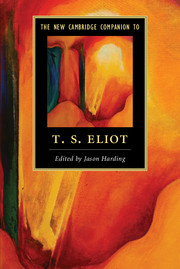Book contents
- Frontmatter
- Contents
- Notes on contributors
- Preface
- Chronology of Eliot's life and works
- List of abbreviations
- 1 Unravelling Eliot
- 2 Eliot: Form and Allusion
- 3 Prufrock and Other Observations
- 4 Banishing the Backward Devils: Eliot's Quatrain Poems and “Gerontion”
- 5 With Automatic Hand: The Waste Land
- 6 “Let These Words Answer”: Ash-Wednesday and the Ariel Poems
- 7 Four Quartets
- 8 “A Precise Way of Thinking and Feeling”: Eliot and Verse Drama 116
- 9 T. S. Eliot as Literary Critic
- 10 T. S. Eliot's Social Criticism
- 11 Gender and Sexuality
- 12 Eliot's Philosophical Studies: Bergson, Frazer, Bradley
- 13 “Anglo-Catholic in Religion”: T. S. Eliot and Christianity
- Select bibliography
- Index
- Miscellaneous Endmatter
Preface
Published online by Cambridge University Press: 01 December 2016
- Frontmatter
- Contents
- Notes on contributors
- Preface
- Chronology of Eliot's life and works
- List of abbreviations
- 1 Unravelling Eliot
- 2 Eliot: Form and Allusion
- 3 Prufrock and Other Observations
- 4 Banishing the Backward Devils: Eliot's Quatrain Poems and “Gerontion”
- 5 With Automatic Hand: The Waste Land
- 6 “Let These Words Answer”: Ash-Wednesday and the Ariel Poems
- 7 Four Quartets
- 8 “A Precise Way of Thinking and Feeling”: Eliot and Verse Drama 116
- 9 T. S. Eliot as Literary Critic
- 10 T. S. Eliot's Social Criticism
- 11 Gender and Sexuality
- 12 Eliot's Philosophical Studies: Bergson, Frazer, Bradley
- 13 “Anglo-Catholic in Religion”: T. S. Eliot and Christianity
- Select bibliography
- Index
- Miscellaneous Endmatter
Summary
In his preface to the 1994 Cambridge Companion to T. S. Eliot, A. David Moody remarked: “For a time after his death in 1965 Eliot himself seemed in danger of becoming simply another monument, frozen in a fixed idea of his achievement. But there is too much life in his work for the accepted idea to contain it; and a new generation of readers, coming to it in the frame of mind of this end of century, are finding that there is much in it which answers to current preoccupations.” Over the succeeding twenty years, major developments have transformed the landscape of our current preoccupations in Eliot studies, leading one Eliot scholar to claim: “Critical work on T. S. Eliot has undergone a renaissance since the early 1990s, bringing new ideas and methods to bear on a much-studied writer whose depths, by then, were long supposed to have been plumbed.” As Gail McDonald observes in her contribution to this volume, the dynamic and controversial subject of Eliot's engagement with gender and sexuality was not treated in the 1994 volume. Furthermore, with the release of a mass of hitherto restricted archive material into the public domain, new generations of readers are asking their own questions of T. S. Eliot. Since 2009, six volumes of The Letters of T. S. Eliot have been published and four volumes of The Complete Prose of T. S. Eliot, taking us up to 1933. A two-volume Faber edition of The Poems of T. S. Eliot, building on the principles established in the 1996 edition of Eliot's early notebook, Inventions of the March Hare, will provide an authoritative text for new readers. These authorised, fully annotated new editions must undoubtedly re-inflect ongoing debates about this complex and challenging poet-critic. Moody's collection was sensitively and intelligently constructed as a gateway for Eliot's readers in 1994, but given the seismic upheaval in Eliot scholarship and criticism since then, it is time for a revised Companion to address the needs of a twenty-first century audience.
- Type
- Chapter
- Information
- The New Cambridge Companion to T. S. Eliot , pp. xiii - xivPublisher: Cambridge University PressPrint publication year: 2016

